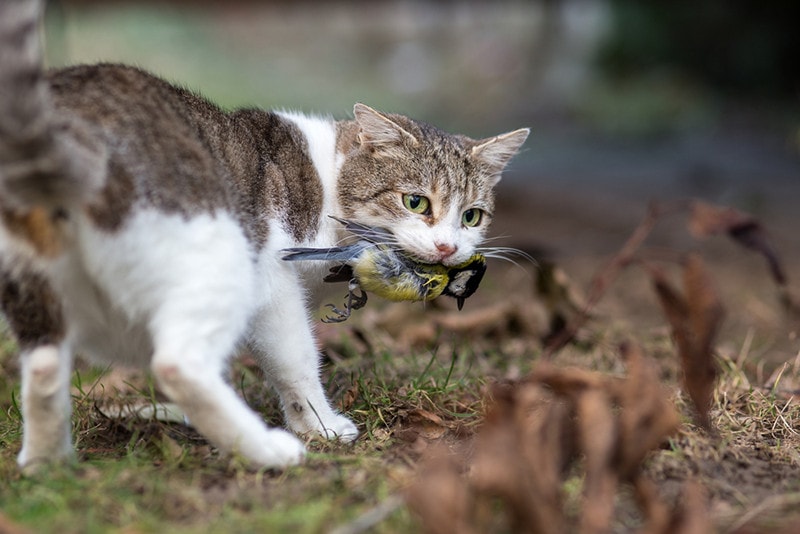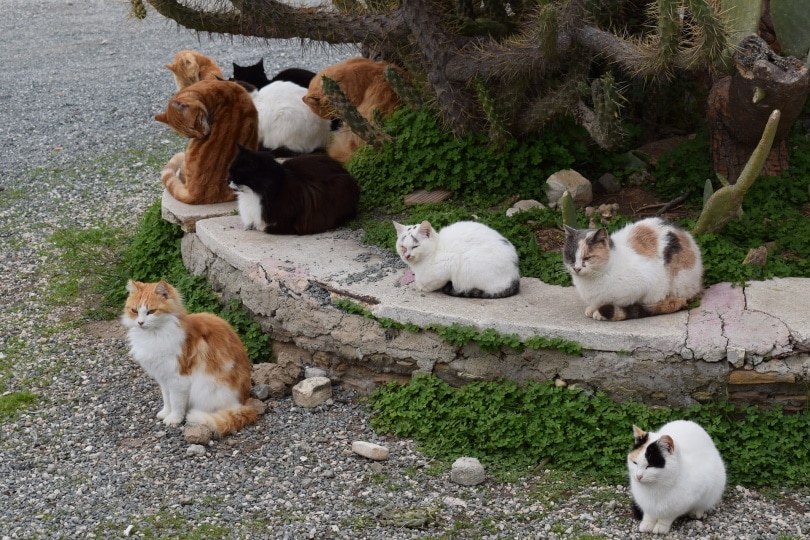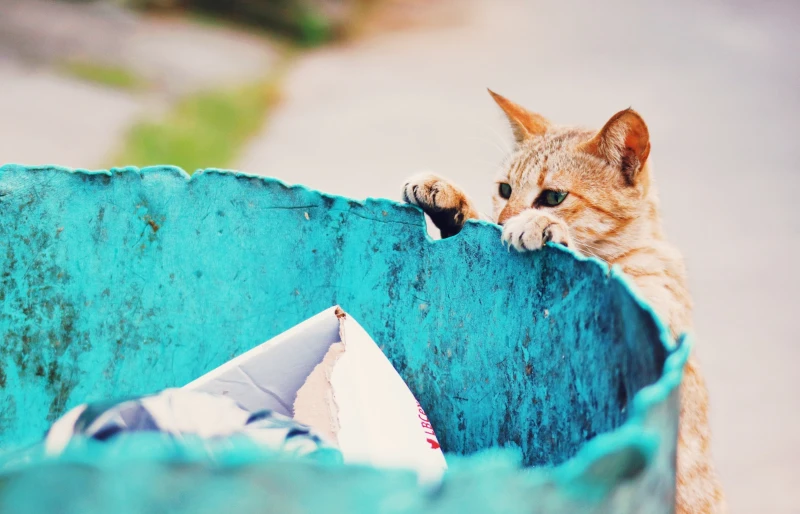
Feral cats have been the subject of much debate and controversy over the years. While some people consider them to be a threat to public health and safety, others believe that they are harmless creatures that deserve our compassion and protection. So, what is the truth about feral cats? Are they really dangerous, or are they simply misunderstood? The short answer is they typically are not aggressive towards people or pets, unless provoked.
In this post, we’ll explore the facts and myths surrounding feral cats and provide you with a better understanding of these free-roaming felines. From their behavior and habits to their impact on the environment, we will examine every aspect of feral cats to help you make an informed decision about how to approach them.

What Exactly Are Feral Cats?
Feral cats are cats that are considered wild and never domesticated or have been abandoned or strayed away from their homes long enough to have learned to live independently without humans. Unlike stray cats, which are usually friendly towards humans and may have been lost or abandoned recently, feral cats are typically wary of humans and have not had much contact with people.
Feral cats are often found living in packs, which are groups of cats that have established a territory and share resources such as food and shelter. They’re skilled hunters and prey on small animals such as birds, rodents, and lizards. Feral cats are also known for their strong survival instincts and are able to adapt to a variety of environments, from urban areas to rural landscapes.
Feral Cats and the Environment
One of the main concerns surrounding feral cats is their impact on the environment. As skilled hunters, feral cats can have a significant impact on local ecosystems, particularly on bird populations. The impact of feral cats on the environment has been extensively studied, with some research estimating that they may potentially kill billions of birds each year in the US alone1. This is a significant threat to many bird species, particularly those that are already endangered or at risk.
In addition to their impact on bird populations, feral cats can also pose a threat to other small animals such as reptiles and mammals. They can also carry diseases such as toxoplasmosis and rabies2, which can be transmitted to humans and other animals.
However, feral cats can also help reduce rodent populations in cities and neighborhoods. Having feral cats around can help keep rodents out of homes and business as these cats often catch and kill mice easily.

Feral Cats and Public Safety
Another issue surrounding feral cats is their potential impact on public safety. Some people believe that feral cats are a threat to public health and safety, citing concerns about the spread of disease and the possibility of feral cats attacking humans or domestic pets. Feral cats can spread many diseases to humans. These include viral (such as rabies), bacterial (such as Yersinia pestis, Campylobacter spp.), fungal (such as Microsporum canis), and parasitic diseases (such as Toxocara or Toxoplasma).
However, it’s important to understand the risks associated with feral cat colonies as well. In addition to their impact on local ecosystems, feral cats can also be a nuisance to nearby residents. They may yowl and fight, which can be disruptive to people trying to sleep or work. They may also defecate in public areas, which can be unsanitary.
The Effectiveness of Trap-Neuter-Return Programs
One approach to managing feral cat populations is trap-neuter-return (aka “TNR”) programs. These programs involve trapping feral cats, neutering or spaying them, and returning them to their original location. The idea behind TNR programs is that they can help to control feral cat populations while also reducing the impact of feral cats on local ecosystems.
While TNR programs have been successful in many areas, there is still lots of debate over their effectiveness. Some critics argue that TNR programs simply perpetuate the existence of feral cat colonies and do not address the underlying issue of overpopulation. Others argue that TNR programs are a humane and effective way to manage feral cat populations and reduce their impact on the environment.

Myths and Misconceptions About Feral Cats
There are many myths and misconceptions surrounding feral cats, which can make it difficult to have an informed discussion about how to manage them. One common myth is that feral cats are always sickly and malnourished. Though they may not always be malnourished, it is safe to assume that they may be carrying a higher number of diseases and pathogens than indoor cats.
Another myth is that feral cats are inherently dangerous to humans and domestic pets. While it’s true that feral cats can carry diseases and may be wary of humans, they are typically not aggressive towards people or pets, unless provoked.
Tips for Safely Interacting with Feral Cats
The AVMA discourages the common public from approaching or feeding feral cats. This is because of the diseases they may transmit to humans and/or our pets. In addition, feeding them is discouraged, as this will likely lead to a higher population of feral cats in the area. If you notice a colony of feral cats, you should report them to the relevant local or state authorities.
Managing Feral Cat Populations
One of the best ways to manage feral cat populations is to promote responsible pet ownership and spaying/neutering. By spaying or neutering your pets, you can help prevent them from contributing to the overpopulation of feral cats. Additionally, by keeping your pets indoors, you can help prevent them from encountering feral cats and potentially spreading diseases.

Ways to Help & Reduce Feral Cat Populations
There are many organizations dedicated to advocating for and rescuing feral cats. These organizations provide a variety of services, including adoption services, trap-neuter-return programs, and education and outreach programs. Some of the most well-known feral cat advocacy organizations include Alley Cat Allies, the Feral Cat Coalition, and the Best Friends Animal Society.
Eliminate Food & Shelter Sources
Feral cats will live in areas where there is plenty of food. To prevent unwelcome cats from eating outside, cover any trash scraps with a lid. Don’t add meat scraps to your compost pile. You can also remove their shelter by making sure to clear out and close up areas beneath your house that they may use to hide, eat, and nest.
This may include the area beneath your porch, entrances to sheds, beneath decks, and behind thick bushes. Ultimately, you want to make the area around your home as cat-proof for feral cats as possible.

Get Your Cats Neutered/Spayed
Males that are unaltered will be attracted by female cats who are in heat. Spaying your female cat will make it less likely that wandering males will be attracted to your home, particularly if you allow your cat to go out in the yard from time to time. Neutering your male cat will also help keep feral female cats that are in heat away from your home.
Call Animal Control
Many communities have animal control specialists who will take care of wild or domestic animals that pose a danger to the community. Your community will determine the level of involvement.
Use Humane Traps
For feral cats, spring-loaded humane traps are also a good option (if permitted) if they become an issue around your home or neighborhood.
Please be warned that in many jurisdictions, it is illegal to own, arm, and use spring traps for wildlife without authorization from the relevant authorities. ALWAYS refer to the laws of your city/state of residence before attempting to capture a wild animal. If an animal is a perceived threat to you or your community, report the situation to animal control and do not attempt to catch them on your own.
You should be aware, that other creatures such as squirrels, opossums, or raccoons, may also get caught in your traps. Animals that are legally protected cannot be placed in traps, and you may face legal consequences if they end up in a trap you place without permission.


Conclusion
Feral cats are complex, yet wild felines that are often misunderstood. While they have a significant impact on local ecosystems and may pose risks to public safety, they still deserve our compassion and protection.
By finding a balanced approach to feral cat management that takes into account the needs of both humans and cats, we can ensure that these creatures are able to thrive in the wild while also minimizing their impact on our communities.
Featured Image Credit: ivabalk, Pixabay






